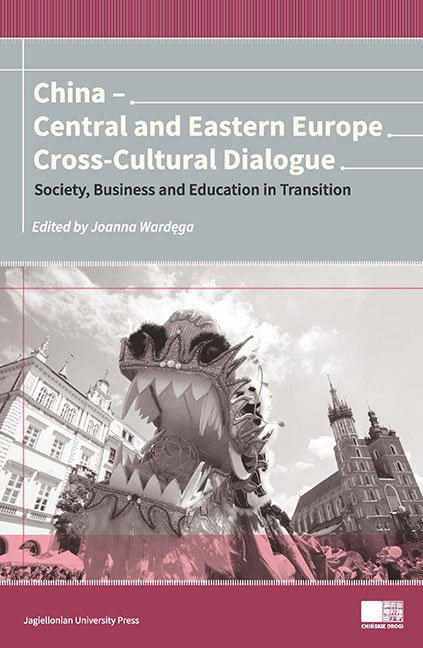Book contents
- Frontmatter
- Contents
- Foreword
- PART I Society and Culture in Transition
- PART TWO Economy and Markets in Transition
- Chinese Economic Influence on the Central and Eastern Europe Countries
- The New Silk Road and its Geopolitical Consequences for Poland
- Comparing Chinese, Japanese and South Korean FDI in Central and Eastern Europe
- Partnership through Investment – Chinese Foreign Direct Investment in CEE Countries
- Chinese Foreign Direct Investments in Europe. The Polish Case
- Fourteen EU States Already in, Japan and USA Still not Interested – What Lies Behind China-led AIIB?
- What Can CEE and China Learn from Each Other in Innovation?
- Comparison of Telecommunications Development Pattern in China and the Republic of Macedonia
- Development of Chinese Mobile Phone Game Market as an Export Opportunity for CEE Mobile Game Producers
- PART THREE Education in Transition
- Contributors
Comparing Chinese, Japanese and South Korean FDI in Central and Eastern Europe
from PART TWO - Economy and Markets in Transition
Published online by Cambridge University Press: 22 December 2017
- Frontmatter
- Contents
- Foreword
- PART I Society and Culture in Transition
- PART TWO Economy and Markets in Transition
- Chinese Economic Influence on the Central and Eastern Europe Countries
- The New Silk Road and its Geopolitical Consequences for Poland
- Comparing Chinese, Japanese and South Korean FDI in Central and Eastern Europe
- Partnership through Investment – Chinese Foreign Direct Investment in CEE Countries
- Chinese Foreign Direct Investments in Europe. The Polish Case
- Fourteen EU States Already in, Japan and USA Still not Interested – What Lies Behind China-led AIIB?
- What Can CEE and China Learn from Each Other in Innovation?
- Comparison of Telecommunications Development Pattern in China and the Republic of Macedonia
- Development of Chinese Mobile Phone Game Market as an Export Opportunity for CEE Mobile Game Producers
- PART THREE Education in Transition
- Contributors
Summary
Introduction
Chinese outward FDI is one of the most spectacular cases of today's international economics in terms of rapid growth, geographical diversity and cases of takeovers of established western brands. Chinese firms mainly invest in Asia, Latin America and Africa, where they search for markets and natural resources. Developed economies however also became their important targets, offering markets for Chinese products and assets, that Chinese firms lack. Moreover, Chinese firms increasingly invest in Central and Eastern European countries (CEECs). These investments constitute a small share of China's total FDI in Europe (10%) and are quite a new phenomenon; but since 2006, rising inflows of Chinese investments could be observed, which are expected to increase (McCaleb & Szunomár, 2013).
Chinese companies however are not the first investors in CEECs from East Asia, as Japanese and South Korean FDI started to flow into the region in the early 1990s. Among the East Asian investors, South Korea has a dominant role in the Czech Republic and Slovakia, Japan is the main investor in Poland, while China recently acquired a dominant position in Hungary.
The aim of the paper is to analyse and compare motivations and location determinants of Chinese, Japanese and South Korean FDI in the largest recipient countries within the CEECs – namely Hungary, Poland, the Czech Republic and Slovakia – with special focus on the role and impact of host country macroeconomic and institutional factors.
After the introductory section, the paper presents the theory and literature on FDI location determinants with special focus on FDI determinants in CEECs. The paper's main section contains findings on similarities and differences in characteristics and motivations of Chinese, Japanese and South Korean FDI in CEECs. In addition, it provides a detailed description of the impact of both macroeconomic and institutional factors.
Theory and literature review
Majority of research on motivations for FDI apply the eclectic or OLI paradigm by Dunning (1992, 1998) that states that firms will venture abroad when they possess firm-specific advantages, i.e. ownership and internalization advantages, and when they can utilize location advantages to benefit from the attractions these locations are embedded with. Different types of investment incentives attract different types of FDI which Dunning (1992) divided into four categories: market-seeking, resourceseeking, efficiency-seeking and asset-seeking.
- Type
- Chapter
- Information
- China - Central and Eastern Europe Cross-Cultural Dialogue Society, Business and Education in Transition , pp. 199 - 212Publisher: Jagiellonian University PressPrint publication year: 2016

